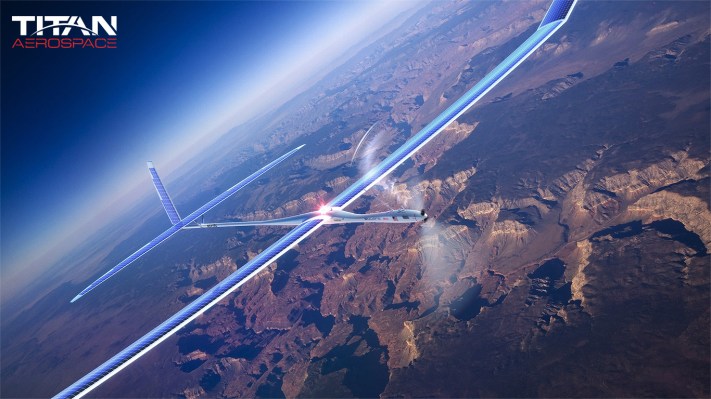Titan Aerospace, the drone maker Facebook had been in acquisition talks with prior to being bought by Google (as we’ve now confirmed following The WSJ’s initial report), was a name that took many in the industry by surprise. How was it that a company that reportedly has solar-powered drones that can fly at 65,000 feet above sea level for five years without needing to land, did not have more public attention or media coverage? The answer, as it turns out, is that there may not have been too much to actually cover yet, as the company was very young.
For starters, it hasn’t been around long enough to prove that its drones can fly for five years, because the company itself isn’t that old. This is partly why investors were passing on further fundraising, we understand — it was too soon. However, we hear that Titan, though early, was still further along in some regards than other drone makers getting bought, including recent Facebook acquisition Ascenta, which went for $20 million.
Titan’s number, when it comes out, will be much higher than that, we hear, as news that Facebook was sniffing around played a role in terms of negotiations.
What Does Titan Have?
Titan had registered just one aircraft with the FAA in 2011 — the remaining small handful have been registered in either 2013 or 2014 — indicating its still-early nature. The team worked out of a nondescript New Mexico house, one source pointed out to us, referencing a Titan employee’s YouTube video titled “walk through of the Titan crew’s new house in new Mexico.”
A number of Titan’s hires are also more junior-level people who believed in founder Maximus (Max) Yaney’s vision. Only around a year ago did the company make its first notable hire worth issuing a press release about, when it brought in CEO Vern Raburn, who previously founded Eclipse Aviation, to run things.
In its early days, Titan bootstrapped itself through a small grant from the state of New Mexico. In this document from the New Mexico Economic Development Department, dated Q2 2013, Titan Aerospace is described as being in the “final stages of R&D” for its solar-powered unmanned vehicles. The company at that time had 12 employees and was working with Technology Ventures Corporation (TVC), a nonprofit foundation by Lockheed Martin that helps companies commercialize technology invented at Sandia National Labs and other New Mexico-based research entities.
According to the report, Titan was working with TVC on an application for a Small Business Innovation Research grant, and it was also meeting with JTIP, an incentive program that pays for on-the-job training to help “fund training for future staff.”
This is an interesting way to go about funding a company which has come up with breakthrough technology – but there’s a reason why Titan may have gone after grants like this, as we alluded to before: Raising from traditional investors was still tough, and Titan wasn’t at the point where it could prove anything about whether or not its ideas would work.
For example, though there are recordings of flights on YouTube, they aren’t demos of what the final product promises. There is this video of a prototype taking flight, but it’s at about 2,000 feet in the air (not 65K) and it’s at a smaller scale than the proposed Solara models. The 2013 proof-of-concept test, which took place in Moriarty, N.M., was the company’s biggest, publicly detailed achievement to date. Titan didn’t have plans to begin production of the Solara 50 aircraft — weighing 400 pounds with a 162-foot wingspan, until mid-2014, it was previously reported.
We hear that Titan will have another milestone to publicize soon, however, following this Google deal.
That above report also pointed out that high-altitude, solar UAVs have been tried in the past, including by Boeing, which had been making progress on its SolarEagle until DARPA funding was cut, and AeroVironment, who developed the Helios prototype for NASA, which failed. Titan believed it could do better.
But patent searches for Titan Aerospace and founder Yaney come up short (even variations like Titan Holdings or Corporation), which is curious. There’s a Titan Aerospace Electronics Division with several non-drone patents, but it appears to be another company pre-dating this Titan.
Titan itself was an interesting entity. A cached version of the Titan website showed that the company used to use the Waldorf Astoria’s NYC address as its New York location. This was because Yaney was based in New York, and at one time had an office there with a small team for Titan.
Titan’s drones were still in the R&D phases when Facebook came knocking. Facebook wanted to accelerate the production of the aircraft, which the company knew would be tricky because, in the development stage, the process is serial, not parallel. But Facebook’s effectively unlimited capital could speed up some things, like production planning or automating equipment purchases. Google could now do the same, under its Project Loon umbrella, or elsewhere –potentially using the tech to augment its work with aerial imagery or having the drones carry atmospheric sensors, notes The WSJ.
Or, in other words, as Google buys Titan, it’s definitely getting in on the ground (ahem) level here.
Additional reporting by Josh Constine
